Chapter 2 Early Middle Ages
The Early Middle Ages was Circa 500–1000 AD; it is sometimes referred to as the Dark Ages, as there was a relative scarcity of literary and cultural output in Western Europe.
Peoples of the Early Middle Ages
[edit | edit source]

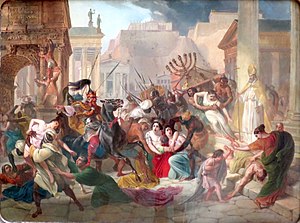
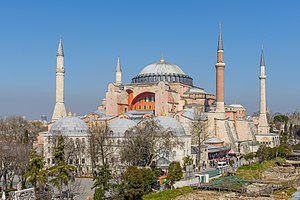
The peoples of the Early Middle Ages included Indo-European peoples, but also some peoples who were not Indo-European, such as Turkic and Uralic peoples. Indo-Europeans can be divided into Germanic peoples, and Indo-Europeans who were not Germanic such as Greco-Romans, Celts, and Slavs.
Germanic peoples
[edit | edit source]Germanic peoples can be divided into West, East and North:
West Germanic peoples included:
- Anglo-Saxons, the Angles, Saxons, and Jutes; they inhabited Jutland and northern Europe, and founded Anglo-Saxon England (c. 500–1066).
- Franks, that spread across Europe from the north, to form Francia/Carolingian Empire (from 481, divided in 843).
- Lombards, who inhabited the Kingdom of the Lombards (568–774), which covered much of the Italian Peninsula.
- Suebi, who inhabited the Iberian Kingdom of the Suebi (409–585).
- Frisii, who inhabited the Frisian Kingdom (c. 600–734) near the North Sea.
Other West Germanic peoples included: Chatti/Hessians (who inhabited Hesse in Roman times); Alemanni (who inhabited Alamannia/Swabia); Bavarii (who inhabited Bavaria); and Thuringii (who inhabited Thuringia).
East Germanic peoples included, most importantly, Vandals, Goths, and Burgundians:
- Vandals (an East Germanic people) spread across Western Europe, Iberia, Carthage, and across the Mediterranean Sea to Rome; the Vandal Kingdom (435–534) included North Africa and Carthage; Corsica; Sardinia; Sicily. Eventually fell to the Byzantines.
- Goths (an East Germanic people) included Visigoths and Ostrogoths. Visigoths spread across the Balkan Peninsula, Italy, Rome, southern France; the Visigothic Kingdom (418–c. 720) included much of Iberia and southern France. Eventually fell to Islam, Asturias and Francia. Ostrogoths spread across Europe to Rome to form the Ostrogothic Kingdom (493–553), of Italy and the west Balkans, after the murder of Odoacer. Eventually fell to the Byzantines and the Avar Khaganate.
- Burgundians (an East Germanic people) formed the Kingdom of the Burgundians/Burgundy (411–534), before falling to the Franks.
Other East Germanic peoples and territories included: Gepids (and the Kingdom of the Gepids); and Rugii (and Rugiland).
North Germanic peoples included: Danes, Swedes, Geats, Gutes and Norsemen.
- Danes: inhabited the province of Scania, now in southern Sweden; they moved to the Jutland peninsula (modern-day Denmark), and would migrate from there as Vikings.
- Geats (Götar) and Swedes (Svear) were from the north of Scania; Gutes (Gutar) inhabited the island of Gotland. They would gave rise to modern Swedes. The Geats may have given rise to the Goths, but this is uncertain.
- Norsemen, or Norwegians, inhabited the petty kingdoms of Norway, and would migrate from there as Vikings.
Other Indo-European peoples
[edit | edit source]Indo-European speaking peoples, other than Germanic peoples, included:
- Celts were widespread across Europe:
- Celtic Britons inhabited England and Wales, and also Brittany.
- Gaels (also know as Scoti) inhabited Ireland, and later Scotland.
- Gauls, of Gaul (present-day France).
- Celtiberians, of Iberia (present-day Spain and Portugal).
- Galatians, of ancient Anatolia (present-day Turkey).
- Picts, who may have been Celtic, inhabited Scotland.
- Greco-Romans ruled the Byzantine Empire, and spoke Ancient Greek (a Hellenic language) and Latin (an Italic language).
- Slavs: could be divided into North Slavs (which includes East and West Slavs); and South Slavs.
- West Slavs would settle in Eastern Europe areas south of the Baltic Sea.
- East Slavs would settle in areas that correspond to present-day Belarus, central and northern Ukraine, and parts of western Russia.
- South Slavs would settle in the Balkans.
- Balts, lived near the Baltic Sea, and are related to Slavs. Peoples included the Lithuanians, Latvians, and Old Prussians.
- Iranians: included the Eastern Iranian Alans and Pashtuns (ethnic Afghans); in the Middle East there were the Western Iranian Persians and Kurds.
Celtic Britons in Britain were conquered by the Romans, but the Roman garrison was abandoned in 410 AD. This paved the way for Anglo-Saxon invasions from the east. Britons held out against Anglo-Saxons in Wales and Dumnonia (South West England). Britons had started to emigrate to Brittany towards the end of the 4th century. Related languages of the Britons are Welsh, Cumbric, Cornish, and Breton.
Early Slavic kingdoms included Samo's Empire (631–658) and Carantania (658–828).
Other peoples
[edit | edit source]Apart from the Indo-European speakers, Europe included:
- Turkic peoples: early Turkic peoples included Khazars and Bulgars; they may have included Huns. Also see the section Turkic migration.
- Uralic peoples included:
- Magyars (of the Principality of Hungary).
- Sami (of northern Scandinavia).
- Finns (of Finland).
- Related to the Finns were the Livonians (Latgalians) and Estonians.
- Pannonian Avars (of uncertain affiliation) would form the Avar Khaganate in the 6th century, before falling to the Bulgars.
- Afroasiatic peoples: Berbers (of North Africa) and Arabs (of Arabia) would later press north into Iberia, and would be known as Moors.
Turkic migration and Viking Age
[edit | edit source]Migrations of other peoples continued after the Migration Period (c. 375 to 538 AD), which had seen movements particularly in Germanic peoples and Huns.
Turkic migration
[edit | edit source]

Turkic migration was between the between the 6th and 11th centuries. There was an expansion of Turkic tribes over Asia and Eastern Europe. The earlier Huns may have been Turkic.
The first Turkic empire was the Göktürk Khaganate (552–603); also called the First Turkic Khaganate, it stretched across Asia from Manchuria to the Black Sea. Although short-lived, it was followed by a succession of Turkic khaganates and khanates in Asia and eastern Europe. Examples include the Second Turkic Khaganate, Uyghur Khaganate, Yenisei Kyrgyz Khaganate, Kara-Khanid Khanate, Khazar Khaganate, Türgesh Khaganatem, Kipchak Khanate, Cumania (or Cuman–Kipchak confederation), and Pecheneg Khanates.
Some early Turkic peoples spoke Oghur languages:
- Bulgars, who founded Old Great Bulgaria (632–668), which gave rise to the First Bulgarian Empire (681–1018) and Volga Bulgaria (7th century–1240s).
- Khazars, who founded the Khazar Khaganate (c. 650–969) north and east of the Black Sea.
Turks (from the Oghuz branch of languages) and Tatars (mainly from the Kipchak branch of languages) were also prominent. Starting in the late eleventh century, the Seljuk Turks from Central Asia migrated over large areas of Anatolia (present-day Turkey), eventually creating a Turkish majority there.
Today Turkic peoples are mainly represented by Turks, Azerbaijanis, and Turkmen (from the Oghuz branch); Uzbeks and Uyghurs (from the Karluk branch); and Kazakhs and Tatars (from the Kipchak branch).
Viking Age
[edit | edit source]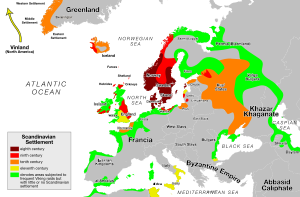
Viking Age (793–1066): began with the raid on Lindisfarne (793). Vikings were migrating North Germanic peoples, which included Danes, Swedes, and Norsemen (Norwegians); although Vikings are sometimes called "Norseman", as the term "víkingr" was applied only to plunderers, rather than traders and settlers.
From their homelands in Denmark, Norway, and Sweden, they settled in the British Isles and Ireland, Faroe Islands, Iceland, Greenland, Normandy, the Baltic coast, eastern Europe, and Vinland (probably Newfoundland). They founded the Kingdom of the Isles (Isle of Man, the Hebrides, and the islands of the Firth of Clyde), the Earldom of Orkney, Scandinavian York, Danelaw (now England to the east), the Kingdom of Dublin, and the Duchy of Normandy. The Varangians (also known as Rus') were Viking Swedes that traveled along the Volga and Dnieper rivers, and may have founded Kievan Rus', an early Russian federation, as the Rus' people.
Vikings would give rise to Normans, descendants of Vikings who settled in Normandy, and would conquer England and south Italy in the High Middle Ages. Their descendants would also give rise to Norse-Gaels, Faroese, and Icelanders.
Other peoples
[edit | edit source]Of the Germanic tribes, Franks would become the dominant Germanic tribe on mainland Europe by the end of the eighth century, outside of Scandinavia.
Other prominent migrations and expansions included:
- Pannonian Avars would form the Avar Khaganate (567–after 822) in the Carpathian Basin.
- Magyar tribes, also called the Hungarian clans, migrated west, and conquered the Carpathian Basin starting in the late ninth century to create the Principality of Hungary.
- Arabs and Berbers would become prominent with Islamic expansion from the seventh century, and would be commonly referred to as Saracens and Moors.
- Slavs, by the seventh century, would begin to create Slavic states, beginning with Samo's Empire (631–658).
During the High Middle Ages, the Mongols, would sweep across Asia, and influence the development of Russia and the Middle East.
Italian Peninsula in the Middle Ages
[edit | edit source]Ostrogoths, Vandals, Byzantines, and Lombards
[edit | edit source]
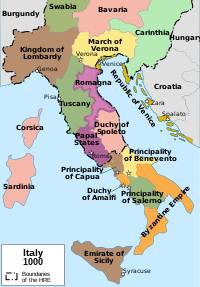

With the fall of Rome, Odoacer's Kingdom Of Italy (476-493) was established, which included some surrounding territory. It was conquered by Theodoric the Great, who was:
- King of the Ostrogoths (475–526).
- King of Italy (493–526), with the Ostrogothic Kingdom including Italy and neighboring areas.
- King of the Visigoths (511–526), with the Visigothic Kingdom including much of Iberia and what would become southern France.
Corsica, Sardinia, and Sicily became part of the Vandal Kingdom (435–534), along with some of North Africa and Carthage.
Both the Ostrogothic and Vandal kingdoms were conquered by the Byzantine Empire under Justinian I (527–565), after the Gothic War (535–554) and the Vandalic War (533–534); and Italy and surrounding islands became part of the Byzantine Empire under the Justinian dynasty (518–602).
Starting in the 6th century, much of Italy was eventually conquered by Lombards (a West Germanic people) from the Byzantine Empire. The Kingdom of the Lombards was at its greatest extent around 749–756, and could be divided into Langobardia Major and Langobardia Minor:
- Langobardia Major, which was the northern Lombards, which included (i) Neustria (in the north-west, later called Lombardy); (ii) Austria (in the north-east, later called the March of Verona); and (iii) Tuscia (south of Neustria, later called Tuscany).
- Langobardia Minor, which was the central and southern Lombards; this included the Duchy of Spoleto and the Duchy of Benevento.
- The rest of Italy was Byzantine territories, and included some of central and southern Italy (including Rome), Sicily, and Sardinia.
Northern and central Italy
[edit | edit source]The Holy Roman Emperor Charlemagne (of Francia) conquered the Lombard Kingdom by 774, which covered much of Italy; but the Principality of Benevento (a Lombard former duchy) maintained de facto independence for nearly 300 years, although it was divided after 849. Venice remained unconquered, the Papal States were under the rule of the pope, and the Byzantine Empire maintained territories in the south.
From the 9th century onward, northern and central Italy could be divided into the Kingdom of Italy, Papal States, and Republic of Venice:
- Kingdom of Italy (of the Holy Roman Empire) in northern and central Italy. It was claimed by the Holy Roman Empire, but with time its power would wane. Italian city-states within it would start to assert de facto independence, or come under the influence of European dynasties; they would include Milan, Florence, Genoa, Pisa, Lucca, Cremona, Siena, Città di Castello, Perugia, and others; and see Venice below.
- Papal States, which were provided with a legal basis with the Donation of Pepin in 756, which conferred upon the pope various territories. This was by Pepin the Short, the first Carolingian King of the Franks. Its status with the Kingdom of Italy is disputed.
- Republic of Venice was officially recognized as Byzantine territory in 814, but would become a powerful and independent city-state and empire.
Southern Italy and Sicily
[edit | edit source]In the 9th century, Moors captured Sicily from the Byzantines, to form the Muslim Emirate of Sicily (831–1091).
Normans would conquer southern Italy and Sicily between 999 and 1139. Roger II of Sicily, who was King of Sicily (1130–1154) and King of Africa (1148–1154), consolidated the Norman kingdoms into one, which covered Sicily, southern Italy, and some north Africa.
The Norman Kingdom of Sicily fell in 1194 to Frederick II, Holy Roman Emperor and House of Hohenstaufen. Later on it would fall to the Capetian House of Anjou (1266); but in 1282, King Charles I of Sicily was forced to leave the island of Sicily by Peter III of Aragon. Charles, however, maintained his possessions in southern Italy.
The Kingdom of Sicily would officially split into two with the Treaty of Villeneuve (1372):
- Kingdom of Naples, officially the Kingdom of Sicily, continued in southern Italy, under the House of Anjou. Its unofficial name was its capital city.
- Kingdom of Sicily, officially the Kingdom of Trinacria (an ancient name for Sicily), continued on the island of Sicily under the Crown of Aragon and House of Barcelona.
Naples and Sicily would later become reunited under the Crown of Aragon in 1443; but they would remain separately administered, only combined as the Kingdom of the Two Sicilies in 1816. In 1469, King Ferdinand II of Aragon married Infanta Isabella of Castile (Queen of Castile and León in 1474); it was a dynastic union, and the dawn of the Kingdom of Spain.
Francia and the Carolingian Empire
[edit | edit source]

Francia, also called the Kingdom of the Franks and Frankish Empire, grew from 481 onward into a mighty empire, which was known from 800 as the Carolingian Empire. The Franks were united by Clovis I (who ruled c. 481–511). Clovis was a member of the Merovingian dynasty of Frankish kings, between 450 and 751.
The Battle of Tours (732) in Aquitaine, where the Franks defeated the Umayyad Caliphate, helped to establish Frankish dominance. Charles Martel commanded the Franks at Tours, and established the Carolingian dynasty of Frankish kings.
Charlemagne, Holy Roman Emperor
[edit | edit source]Charlemagne (Charles I, the Great) was King of Francia 768–814; King of the Lombards 774–814; and Holy Roman Emperor 800–814. Charlemagne expanded the kingdom into Bavaria/Carinthia, and Lombard, Saxon and Spanish March territories. Francia by 800 covered much of the former Western Roman Empire, with most of Western and Central Europe; but not including Iberia, Britain, Jutland, Brittany, southern Italy, Venice and the Papal States.
On Christmas Day in 800, Pope Leo III crowned Charlemagne as "Emperor of the Romans" in the Old St. Peter's Basilica in Rome. The office of Holy Roman Emperor, as it became known as, was a revival of the Roman Emperor in the west. Charlemagne's empire from 800 is sometimes called the Holy Roman Empire, but it is more often called the Carolingian Empire, named after the Carolingian dynasty. It was distinct from the later Holy Roman Empire of 962–1806, which was centered on East Francia.
Origins of France and the Holy Roman Empire
[edit | edit source]Charlemagne was succeeded as Holy Roman Emperor by his son Louis the Pious (813–840). On the death of Louis, civil war erupted (840–43), followed by the Treaty of Verdun; Francia was then divided among the three surviving sons of Louis the Pious:
- West Francia, first ruled by Charles the Bald (who later became Holy Roman Emperor and King of Italy). West Francia is considered to be the Kingdom of France with the rule of the Capetian dynasty (987 onward).
- East Francia, first ruled by Louis the German. East Francia would later form the nucleus of the Holy Roman Empire (962–1806) founded by Otto the Great.
- Middle Francia, ruled by Lothair I (who was Holy Roman Emperor). It was a short lived state of territory between West and East Francia.
With the death of Lothair I and the Treaty of Prüm (855), the sons of Lothair I divided Middle Francia into: (i) Lotharingia, which would later became Lorraine and Upper Burgundy, ruled by Lothair II; (ii) Provence, also known as Lower Burgundy, ruled by Charles of Provence; (iii) Italy, the northern peninsula, ruled by Louis II of Italy.
By the time of the Treaty of Meerssen (870), Charles of Provence and Lothair II had both died, and Francia had become:
- West Francia, which contained parts of Lotharingia, and some of Provence; ruled by Charles the Bald at that time.
- East Francia, which contained most of Lotharingia; ruled by Louis the German at that time.
- Italy, the northern peninsula, which had expanded to include most of Provence; ruled by Louis II of Italy at that time.
With the Treaty of Ribemont (880), some Lotharingia territory was returned to East Francia from West Francia. Francia was reunited briefly, between 884–887, under Charles III (the Fat), Emperor between 881–888; after that it then divided again. Charles was the last of the Carolingian dynasty of Holy Roman Emperors, with the exception of the disputed Holy Roman Emperor Arnulph (896–899).
Europe from 814
[edit | edit source]After the death of Charlemagne (814), Europe during the Early Middle Ages included the following states:

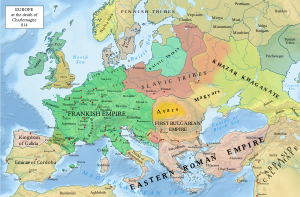
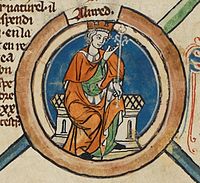
- British Isles
- Alfred the Great, the Anglo-Saxon King of the West Saxons, defeated the Great Heathen Army of the Danish King Guthrum at the Battle of Edington (878) to become first unified King of the Anglo-Saxons. The House of Wessex, which included Alfred, would eventually conquer all of England from the Danes under Æthelstan (c. 927). But there were also Danish kings after this, including Cnut the Great, who reigned over England 1016–1035, as well as Denmark and Norway, as the North Sea Empire. Other tribes of the British Isles included the Welsh and West Welsh (who were Celtic Britons); the Picts; and the Celtic Gaels/Scoti.
- Scandinavia and to the east
- Scandinavia was inhabited by North Germanic peoples, with Danes (in Jutland and Scania), Swedes, Geats, and Gutes. In the Unification of Norway (860s–1020s), the Norwegian Norsemen unified from the petty kingdoms of Norway. Lands of Finns (a Uralic people) lay to the east.
- Western and Central Europe
- Was dominated by Francia (with West Germanic Franks), which remained undivided until 840. Brittany was inhabited by Celtic Britons.
- Slavic states and Balts
- Included Bohemia, with West-Slavic Bohemians, the ancestors of Czechs. Great Moravia (833–c. 907) was a short lived state of the West-Slavic Moravians. Kievan Rus' principalities (882–1240) would form from East Slavic peoples, Finns and Vikings. Serbia (with South-Slavic Serbs) existed as a state between 8th century up to 1371, and then fell to the Ottomans. The Kingdom of Croatia (925–1102) of South-Slavic Croats, developed from the earlier Duchy, and would enter personal union with Hungary in 1102. Carantania (658–828) was a South-Slavic state. The Bulgarian Empire was partly South Slavic. Balts lived near the Baltic Sea, and may have ruled the territory of the Aesti (Esthland or Estonia).
- First Bulgarian Empire (681–1018)
- The earlier Old Great Bulgaria (632–668) was established by Bulgars (a Turkic people); after defeating the Byzantines at the Battle of Ongal (680), the First Bulgarian Empire was established as a Bulgar-Slavic, and later Bulgarian, state. After defeating the Byzantines at the Battle of Achelous (917) it achieved hegemony over much of the Balkans, before falling to the Byzantine Empire. Much later on in the High Middle Ages, the Second Bulgarian Empire (1185–1396) was established after uprisings, which eventually fell to the Ottomans.
- Carpathian Basin
- In the Carpathian Basin (or Pannonian Basin), Pannonian Avars would form the Avar Khaganate (567–after 822). After being conquered by East Francia and the First Bulgarian Empire, the Magyars (a Uralic people) would establish the Principality of Hungary (895–1301), which later became a kingdom.
- Iberian Peninsula
- Included the Islamic Emirate of Córdoba in southern Iberia (which later became a caliphate). In the north was the Christian Kingdom of Asturias (718–924, named after the Celtic Astures), which would later transition to the Kingdom of León (910–1230). A few years later, the Christian Kingdom of Pamplona (later called the Kingdom of Navarre) would be founded; this is traditionally dated to 824.
- Italian Peninsula
- Francia dominated the northern peninsula, and had hegemony over the Papal States. The Republic of Venice (697–1797) was within the Byzantine sphere of influence. In southern Italy, Benevento (571–1077) was ruled by the Lombards, with the Byzantine Empire to the south of Benevento. Later on, the Moors would conquer Sicily from the Byzantines, and the Normans would then conquer Sicily and southern Italy.
- Byzantine Empire and to the east
- The Byzantine Empire ruled the southern Balkans and Anatolia. East of the Byzantines was ruled by the Abbasid Caliphate. Khazars (a Turkic people) and Magyars ruled Europe north of the Black Sea.
Reconquista, and unification of Spain
[edit | edit source]Note: this section spans the entire Middle Ages.
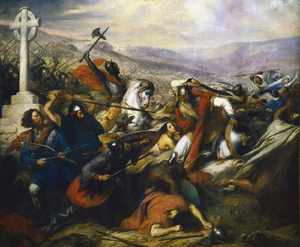






The Umayyad conquest of Hispania (711–788) was the capture of Iberia by the Umayyad Caliphate from the Visigoths, who by 624 had gained control of all of Iberia. Hispania was the Roman name for Iberia, which is now Spain and Portugal. The Islamic dominions of Iberia were known as al-Andalus; they were ruled by Muslim Arabs and Berbers known as Moors. The Emirate of Córdoba (756–939) was a splinter state ruled by the Umayyads, after al-Andalus separated from the Abbasid Caliphate. Córdoba would later became a caliphate (939–1031), before splitting into many independent states, called taifas.
The Reconquista was the reconquest of Iberia by Christians, began after the Battle of Covadonga (either 718 or 722), where the Visigoth Pelagius of Asturias defeated the Moors, and the Christian Kingdom of Asturias was founded after it.
The Franks were successful in early battles against the Moors; at the Battle of Tours (732), also known as the Battle of Poitiers, the Frankish leader Charles Martel defeated the Umayyad Caliphate. The battle helped to establish the foundations of the Carolingian Empire, and Frankish domination of western Europe. Established by Charlemagne in 795, the Hispanic Marches was military buffer between the Frankish empire and al-Andalus.
Almanzor, the powerful chancellor of the Umayyad Caliphate of Córdoba between 978 and 1002, waged many campaigns against the northern Christian kingdoms.
Asturias, León, and Galicia
[edit | edit source]Alfonso III of Asturias (866–910) who ruled the Kingdom of Asturias, would consolidate power and have numerous victories over Islamic and Christian opponents. It is assumed that the old Asturian kingdom was divided between the three sons of Alfonso III of Asturias, into the kingdoms of León, Asturias and Galicia. The Kingdom of León was so named as the capital was shifted from the city of Oviedo to the city of León in 910.
The Kingdom of León would unite with the Kingdom of Asturias in 924, with Asturias becoming the Principality of Asturias. The Kingdom of León would at times be in personal union with the Kingdom of Galicia, eventually merging into the Crown of Castile (1230–1715).
Navarre/Pamplona, Castile, and Aragon
[edit | edit source]The Kingdom of Navarre (824–1841), earlier known as the Kingdom of Pamplona, was a northern Basque-based kingdom. Basques speak the Basque language, a language isolate which is closely related to the Aquitanian language spoken by Aquitani. They gained independence from the Emirate of Córdoba. Navarre was ruled by the House of Jiménez 905 to 1234, until acquired by the counts of Champagne in 1234.
Sancho III of Pamplona was King of Pamplona (or Navarre) 1004–1035. He ruled:
- Kingdom of Pamplona, and County of Aragon, by inheritance; Aragon had earlier been under Frankish rule.
- Counties of Castile, Álava, and Monzón by marriage (1011); Castile had earlier been part of the Kingdom of León.
- Counties of Sobrarbe (1015), Ribagorza (1018) and Cea (1030).
- Kingdom of León, by conquest, taking its eponymous capital city in 1034. Bermudo III of León took refuge in Galicia.
Sancho III was also suzerain of the French Duchy of Gascony, and the County of Barcelona. Ferdinand I of León (King of León 1037–1065) was the son of Sancho III, and the first king to be crowned Emperor of Spain (1056).
The upshot of Sancho III's conquests, and dominance of Christian Iberia, was the creation of two new kingdoms:
- Kingdom of Aragon, created in 1035 from the county, for Ramiro I of Aragon, son of Sancho III.
- Kingdom of Castile, created in 1065 from the county, for Sancho II of Castile and León, son of Ferdinand I of León.
The Kingdom of León (which included the Principality of Asturias) and the Kingdom of Galicia would continue, but would eventually unite with the Kingdom of Castile as the Crown of Castile (1230–1715). The Kingdom of Navarre would later be partially annexed by the Crown of Castile in 1512. The Kingdom of Aragon would become the Crown of Aragon in 1162, with the union of Catalonia.
Al-Andalus, and Portugal
[edit | edit source]During the High Middle Ages, al-Andalus (that is, Islamic Iberia) rulers would include the Almoravid dynasty (1040–1147), and Almohad Caliphate (1121–1269). At other times they would be divided into taifas, which were independent Islamic principalities ruled by emirs.
In 1128, with the Battle of São Mamede, the County of Portugal (1093–1139) achieved independence from the Kingdom of León, and then became the Kingdom of Portugal (1139–1910). Portugal would remain independent of Spain, except for the period of the Iberian Union (1580-1640).
Catalonia, and the Crown of Aragon
[edit | edit source]After Barcelona was conquered by the Moors, the city was retaken by Franks in 801, led by Louis the Pious. During the 10th century, the counts of Barcelona became progressively independent of the Franks, and acquired other Catalan counties. In 988 Borrell II, Count of Barcelona, refused to recognize the new dynasty of the Frankish king Hugh Capet; from that point on, the counts of Barcelona often referred to themselves as princeps (prince).
In 1150 Petronilla of Aragon married Raymond Berenguer IV of Barcelona. This would create the dynastic union of the Kingdom of Aragon and County of Barcelona, as the Crown of Aragon. The Crown of Aragon became a personal union with their son Alfonso II of Aragon, King of Aragon (1164–1196) and Count of Barcelona (1162–1196). The County of Barcelona (which included many Catalan counties) would then become known as the Principality of Catalonia, within the Crown of Aragon.
James I the Conqueror (King of Aragon 1213–1276) would expand the crown from Aragon and Catalonia:
- Kingdom of Valencia. El Cid (Rodrigo Díaz de Vivar) had taken Valencia with a Christian and Moorish army, and become Prince of Valencia (1094–1099); it would be fought over by Muslims and Christians, before being conquered by Aragon in 1238.
- Kingdom of Majorca, a realm of the Balearic Islands and on the east coast of Spain, was founded in 1231 after conquest from Moors, and united with the Crown of Aragon in 1258.
James I was also Lord of Montpellier; Montpellier would be sold to the French in 1344. The Crown of Aragon would later include Sardinia, Sicily, and Naples (southern Italy), and other European lands.
Crown of Castile, and Ferdinand III of Castile
[edit | edit source]The Crown of Castile (1230–1715) developed from the kingdoms of Castile and León; during the 11th and 12th centuries, they would be in personal union at times.
St. Ferdinand III of Castile was the son of Alfonso IX of León and Berenguela of Castile, and became king of Castile and Toledo (1217–1252), and king of León (including Asturias) and Galicia (1230–1252). Toledo had been earlier been Christianized with the capture of Toledo by Alfonso VI of León (1085).
In addition to Castile, Toledo, León (including Asturias), and Galicia, Ferdinand III would conquer Islamic territories which became Christian kingdoms:
- Kingdom of Córdoba, with the Siege of Córdoba (1236).
- Kingdom of Jaén, with the Siege of Jaén (1245–1246).
- Kingdom of Seville, with the Siege of Seville (1247–1248).
In 1238 the Emirate of Granada became a tributary vassal to Castile. With the conquest of Murcia (1243), the Taifa of Murcia became a vassal of Castle. Later on the Crown of Castile would obtain:
- Kingdom of Murcia, after the Mudéjar revolt (1264–1266), and reconquest by Castile (1265–1266).
- Lordship of Biscay (1379).
- Kingdom of Granada (1492).
- Upper Navarre (1512).
Outside of Iberia, the crown would obtain a great overseas empire in the New World and other places. Córdoba, Jaén, Seville, and Granada would be known as the Four Kingdoms of Andalusia.
Ferdinand and Isabella, and the end of the Reconquista
[edit | edit source]By 1400 only the Emirate of Granada remained Islamic; Christian Iberia could be divided into:
- Crown of Castile
- Crown of Aragon
- Kingdom of Portugal
- Kingdom of Navarre
King Ferdinand II of Aragon and Queen Isabella I of Castile were later called the Catholic Monarchs; they were both from the House of Trastámara, and their marriage in 1469 and later ascensions to their thrones, marked the de facto unification of Spain (as Aragon and Castile). In 1478, Ferdinand and Isabella launched the Spanish Inquisition primarily to identify heretics, especially among the conversos, those who converted to Catholicism from Judaism. Tomás de Torquemada was the first Grand Inquisitor between 1483 and 1498.
Ferdinand and Isabella completed the Reconquista with a victorious war against the Emirate of Granada (1482–1492). After the Reconquista, the Alhambra Decree (1492) led to the expulsion of Jews from Spain, although Jews who converted to Christianity escaped expulsion. It was followed by forced conversions and expulsions of Muslims; even some moriscos (i.e. Muslims who had converted to Christianity) experienced expulsion between 1609 and 1614. In 1512 Upper Navarre (to the south) was annexed to the Crown of Castile; Lower Navarre (to the north) then entered personal union with France when Henry III of Navarre became Henry IV of France in 1589.
In 1519 the crowns of Aragon and Castile would enter personal union with Charles V, Holy Roman Emperor; from then onward they remained in personal union. During and after the War of the Spanish Succession, the Nueva Planta decrees (1707–1716) unified Aragon and Castile into the crown of Spain.
